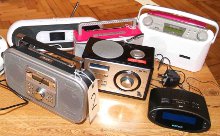A magazine where the digital world meets the real world.
On the web
- Home
- Browse by date
- Browse by topic
- Enter the maze
- Follow our blog
- Follow us on Twitter
- Resources for teachers
- Subscribe
In print
What is cs4fn?
- About us
- Contact us
- Partners
- Privacy and cookies
- Copyright and contributions
- Links to other fun sites
- Complete our questionnaire, give us feedback
Search:
Wake Up! Fix it!: Explore
So, you are a usability expert. You've been set the task of creating a new usable design for a hotel alarm. What do you do?

You've explored the problem design. What next?
Don't just restrict yourself to that problem alarm. You should also look at other existing designs too. Explore them. Do they have the same problems or different problems? Which parts of the design are good and would help a new user see immediately what to do? Which are bad? Try it now. There are probably several alarm clocks and radios round your house. Explore them too. Be critical though. Build up expertise in what makes a good alarm design and what a bad one. Go to a shop that sells digital radios and alarms, do the same for those on display. Which ones are immediately easy to use and which hard? Don't allow yourself to be fooled by the ones that look good. Focus on ease-of-use not looks.
Don't just play. Rather than pressing buttons randomly, think of some tasks to try, then see if you can do them:
Set the alarm to come on in 2 minutes.
Check what time the alarm is set for.
Cancel the alarm
Set a station of your choice as a preset/favourite so you can switch to it in one button press.
Make the alarm use a radio station of your choice as the one it comes on with.
Do it with a purpose. Which tasks take lots of steps to do and which can be done easily? Are the important tasks easy? See what mistakes you make. Think about how well things are labelled. Are colours, sizes and positions of things well thought out? Do you get feedback after each button press?
Start to jot down a list of general ideas over what is important: "Don't have buttons with no label at all", "Make important buttons bigger", and so on.
Exploring lots of gadgets - not just radio alarms - is a good idea and given your experience you will probably see a lot of problems that way. Also new designs don't come out of nowhere. Good designers make sure they know what innovations others are trying and learn from their mistakes and successes, adapting and improving good ideas, avoiding bad ones... using the understanding to do something completely new and better.
As an expert you can do better than just informally explore an existing design though. Read on to find out more.
Back to ...
Wake up! Fix it!More Usability
The Fundamentals of Human Computer InteractionMore Hotels
Hotel Doors and Keycode AlgorithmsCompetitions
Current Competitions
The wake-up. Fix it! series of cs4fn articles is based on a Science Week activity organised by the Department of Computer Science at Queen Mary, University of London, with support from the Research Councils UK.


